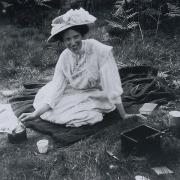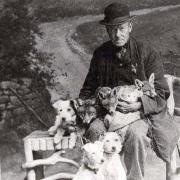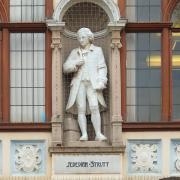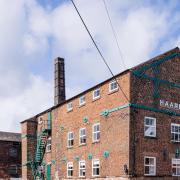The Epping doctor who discovered the cure for smallpox and inoculated the Russian empress.
A doctor, banker, politician and Fellow of the Royal Society – it was certainly quite an innovative CV. Thomas Dimsdale (1712-1800) was all these things and more. Born in Theydon Garnon in Essex on 29 May 1712, Thomas was the son of a surgeon, John Dimsdale, and mother Susan, and was raised a Quaker. Thomas’ grandfather, Robert Dimsdale, another surgeon, was a companion of William Penn (1644-1718), the Quaker founder of Pennsylvania.
Thomas’ own father trained him in the mysteries of medicine before he headed to St Thomas’ in London for further instruction. He began practicing on his own in Hertford in 1734, when he was 22. Around a decade later, Dimsdale served as a doctor with ‘Butcher’ Cumberland, who was marching north to eradicate the Jacobite rebellion of 1745. He was also lucky enough to inherit a cousin’s fortune, which meant he could withdraw from medical practice – although he’d later return in a specialised capacity. He took an M.D. (Doctor of Medicine) at the University of Aberdeen in 1761.
It seems Thomas was especially interested in inoculation or variolation, specifically the prevention of the killer smallpox via deliberately infecting with a mild form of the disease to protect against more virulent variants, something first tried in Europe in 1672. If this rings bells, well, it should after our experience between 2020-22.

Dimsdale wasn’t the first as he copied and improved on procedures from another Essex medic, Robert Sutton (1708-88). Dimsdale published ‘The present method of inoculating for the small-pox’ (1767), which raced through five editions by 1769 and at least seven within its first three years; this undoubtedly was his magnum opus.
That piece of authorship was the catalyst for Dimsdale’s election as a Fellow of the Royal Society, also in 1769. The fight against smallpox, a disease killing around 400,000 per annum in Europe by the 18th century, was urgent. It wasn’t just the commoner at risk. Royal cadavers included Peter II (Russia), Louis XV (France) and Louis I (Spain).
Inoculating with smallpox was risky. You could just as easily kill a patient as immunise them should it all go horribly wrong. It was also important for those inoculated to be quarantined (aka locked down) otherwise you might end up with another epidemic.
Thomas’ approach at least seemed more scientific than earlier remedies, including supping up elixirs made from horse dung or donkey fat. Dimsdale pressed ahead and even got himself invited to Russia in 1762 to inoculate Catherine the Great (1729-96) and her son the Grand Duke Paul, aged 14. Given the propensity for royals to keel over as much as the riff-raff, one can understand the desire to get ‘scratched’ with the virus.
There was a six-year delay before Dimsdale made the trip in 1768 with his second son, Nathaniel, proceeding to variolate not just Catherine and her son but also more than 140 members of the Russian court. Thomas cashed in by publishing his ‘Tracts on Inoculation Written and Published at St Petersburg in the Year 1768’.
One wonders what may have happened to the Dimsdales if it had all turned out badly, although apparently Catherine had nobly hatched plans to smuggle the pair out of Russia should that prove expedient. We presume from this that some of the courtiers may have fancied their guts for garters.
Paul became emperor after Catherine but would perish not from a risky variolation but from assassination, a combination of sword blow, strangling and trampling in March 1801. Dimsdale being chosen to scratch the skin of an empress was due to him becoming quite a respected figure in London society. With the project deemed successful, Dimsdale was rewarded with a lump sum, pension, expenses, baronetcy and position of physician to the Empress; nice work if you can get it.

Dimsdale got away with his inoculation of the Russian royals and entourage, however, there was an improvement coming, namely, to vaccinate using a related but less deadly disease, the cowpox. The credit for achieving the first actual vaccination against smallpox went to Edward Jenner (1749-1823), on 14 May 1796, by which time Dimsdale’s life was almost run.
Jenner faced much opposition, including from vaccine sceptics (not a new phenomenon) before his theories were accepted by the medical profession and the public at large. Jenner’s advancement ultimately saved millions of lives worldwide, but he would have been the first to acknowledge that he owed plenty to the inquiring minds that preceded him, such as Dimsdale.
Just before he received Catherine’s invite, Dimsdale entered a banking partnership (c.1761), which continued post-Russia, as he remained a partner in ‘Staples, Baron Dimsdale, Son & Co’ until his retirement in 1776; our Thomas was clearly happy living off his baronial credentials and flashing them about on his business card.
He also sat in the House of Commons between 1780-90 so was an oddity, a baronial MP (as it were), whilst in 1781 he returned to Russia with Nathaniel to perform more inoculations (some sources say 1784). That bank incidentally became the subject of a merger in 1891, the merged enterprise then becoming a constituent part of Nat West. Dimsdale’s political career seems to have been a non-event meanwhile. He’s only known to have addressed the Commons once, in June 1783, his delivery long-winded but inaudible apparently. ‘Oratory is not one of his talents,’ it was said.
Dimsdale married thrice, firstly in 1739 to Mary (1720-44), daughter of Nathaniel Brassey MP, then in 1746 to Anne, daughter of John Iles who bestowed a brood of seven sons and two daughters before dying in 1779, and lastly Elizabeth, daughter of a Dimsdale cousin.
Thomas died on 30 December 1800, aged 88, being laid to rest in the Quaker burial ground in Bishop’s Stortford. I quite like Dimsdale. Despite all that celebrity and wealth, he only practiced medicine in his last two decades if it was ‘for the relief of the poor’.
CHRONOLOGY
1712 – Birth of Thomas Dimsdale in Theydon Garnon, Essex (29 May).
1761 – Takes the M.D. at the University of Aberdeen and enters a banking partnership.
1767 – Publishes The Present Method of Inoculating for the Small-pox.
1768 – The famous trip to St Petersburg when Dimsdale inoculated Catherine II et al.
1769 – Elected a fellow of the Royal Society.
1780 – Becomes an MP and member of the House of Commons.
1783 – Dimsdale addresses the House of Commons for the one and only time.
1796 – First vaccination against smallpox by Edward Jenner.
1800 – Death of Baron Thomas Dimsdale (30 December) aged 88.



























